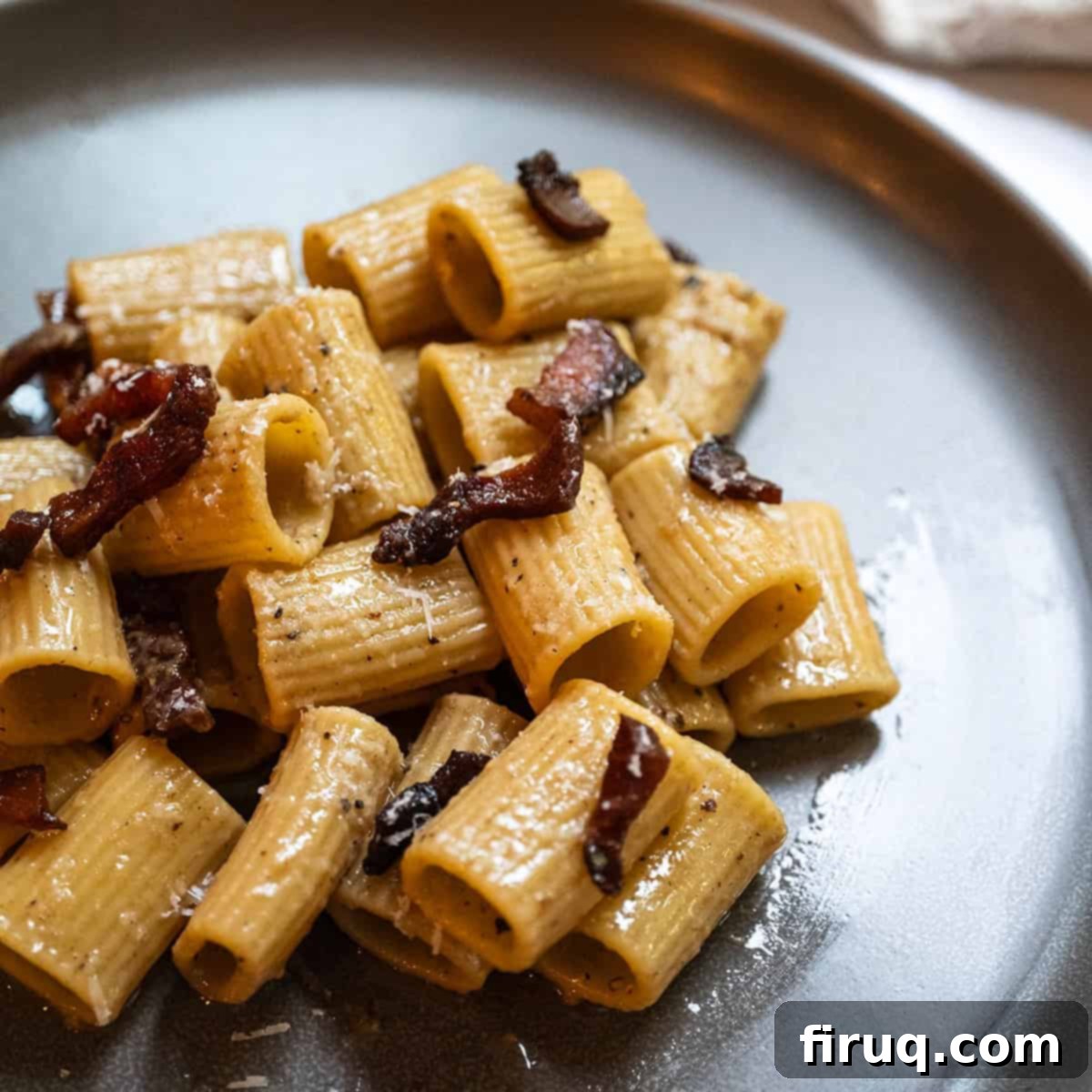Mastering Pasta Alla Gricia: The Authentic Roman Guanciale and Pecorino Pasta
Pasta Alla Gricia is often hailed as the “ancestor” of all Roman pasta dishes, a culinary masterpiece that predates its more famous cousins like Amatriciana and Carbonara. This traditional Roman pasta is a testament to the power of simplicity, relying on just a few high-quality ingredients: rich guanciale, pungent Pecorino Romano cheese, and a generous crack of black pepper. Despite its seemingly humble components, the true magic of Pasta Alla Gricia lies in its precise cooking method and the careful technique applied, transforming these basic elements into an incredibly delicious, silky, and deeply flavorful dish that speaks volumes of Roman culinary heritage.
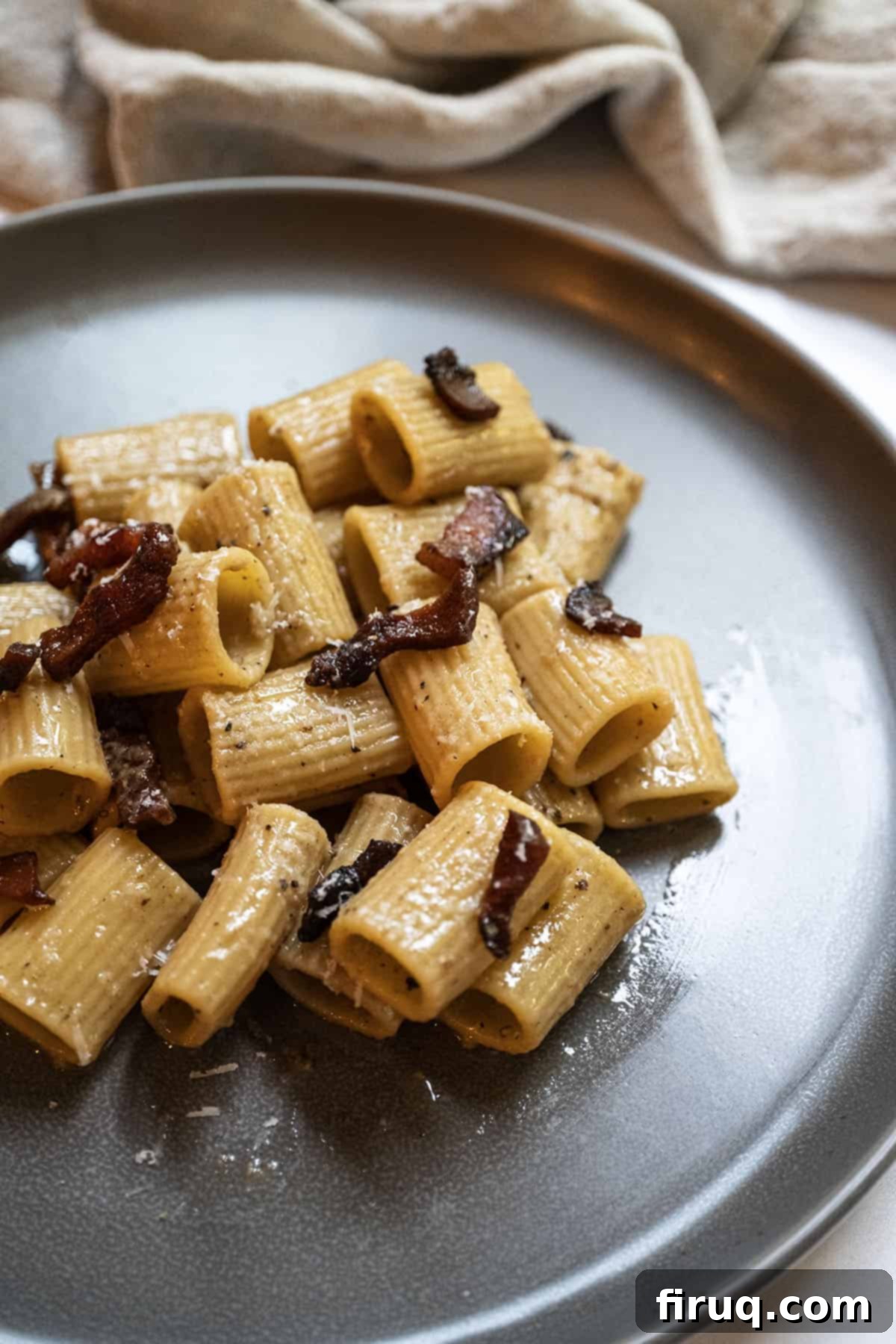
For those seeking more quick and authentic Italian pasta recipes, be sure to explore our 15-Minute Spaghetti with Garlic and Oil, a simple yet flavorful classic, or our hearty Pasta with Peas and Pancetta, perfect for a satisfying weeknight meal.
[feast_advanced_jump_to]
The Storied History of the Four Roman Pastas
Pasta alla Gricia holds a significant place among the four iconic Roman-style pastas, often regarded as the oldest and most fundamental. While it might not be as widely recognized in North America as the beloved Spaghetti Carbonara, the robust Bucatini Amatriciana, or the minimalist Cacio e Pepe, Gricia offers an equally profound and delicious experience. Its simple yet sophisticated sauce is a masterful blend, created from the rendered, rich fat of guanciale, expertly emulsified with starchy pasta water, and then perfectly combined with generous amounts of finely grated Pecorino Romano cheese.
Historically, Amatriciana is believed to have evolved directly from Pasta alla Gricia. The key distinction between these two classic dishes is merely the addition of tomatoes to Gricia’s base. This highlights Gricia’s foundational role in Roman cuisine. Furthermore, a crucial element that elevates Gricia is the inclusion of *freshly cracked black pepper*, which provides a delightful warmth and a subtle spicy kick that complements the rich guanciale and salty Pecorino Romano beautifully. The authenticity and depth of flavor in these classic Italian dishes are deeply rooted in their long histories, making it paramount to respect and utilize their traditional ingredients to truly capture their essence. Much like Pasta alla Norma, a celebrated Sicilian dish, Gricia embodies centuries of culinary tradition in Italy.
Essential Ingredients for Authentic Pasta Alla Gricia
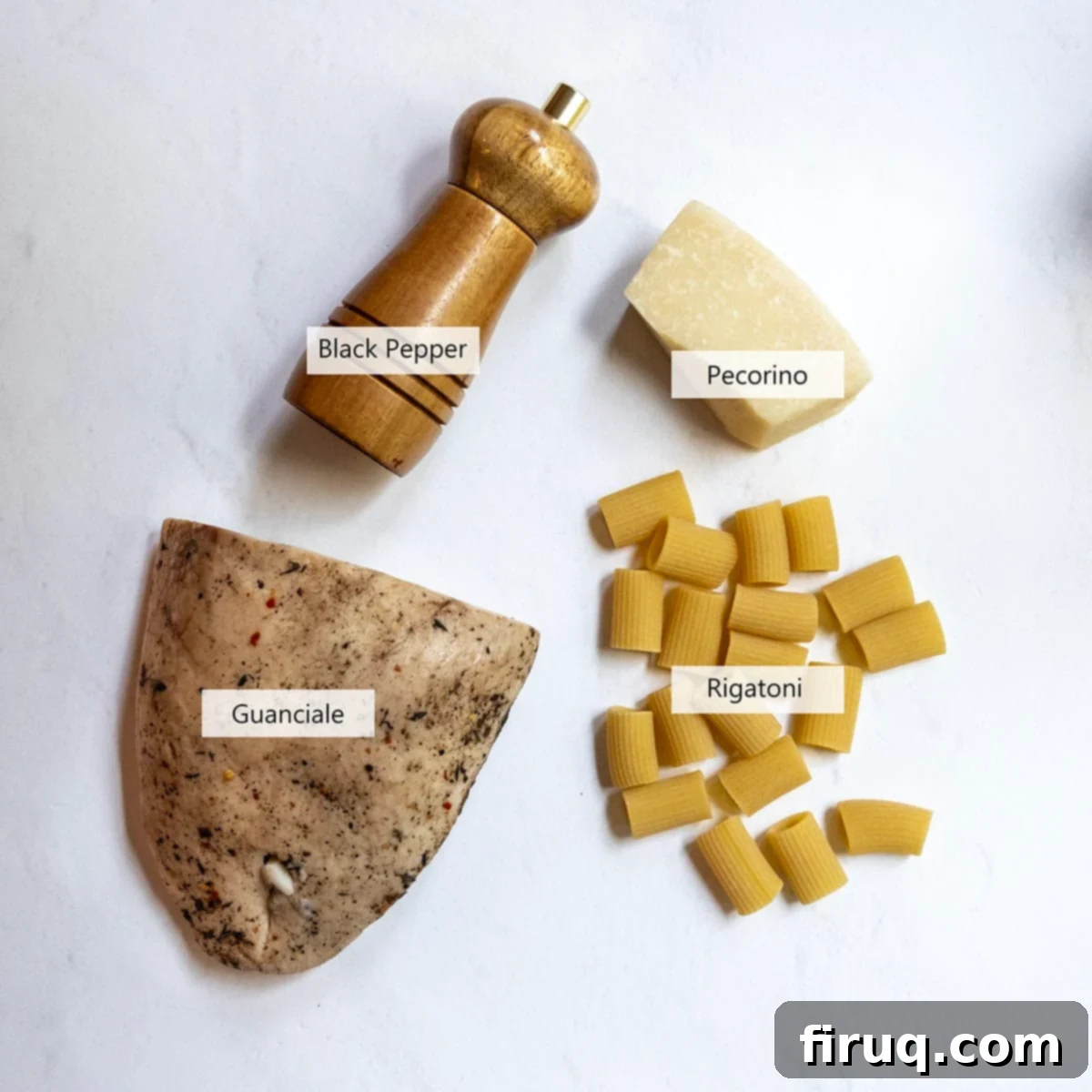
Crafting a truly exceptional Pasta Alla Gricia hinges on selecting and preparing the right ingredients. Each component plays a vital role in achieving that authentic Roman flavor and texture.
Guanciale. The undisputed star of this dish, guanciale (cured pork jowl) is absolutely critical. Its unique curing process results in a richer, more complex flavor and a higher fat content than pancetta or bacon. The copious fat renderings from guanciale are the foundation of the sauce, imparting a deep, savory flavor and a luxuriously silky, creamy texture. For best results, it should be chopped into strips or small cubes, as shown below, to ensure a perfect balance of crispy meat and rendered fat in every bite. While pancetta can be a distant substitute in a pinch, guanciale’s distinct flavor profile is irreplaceable for true Gricia.
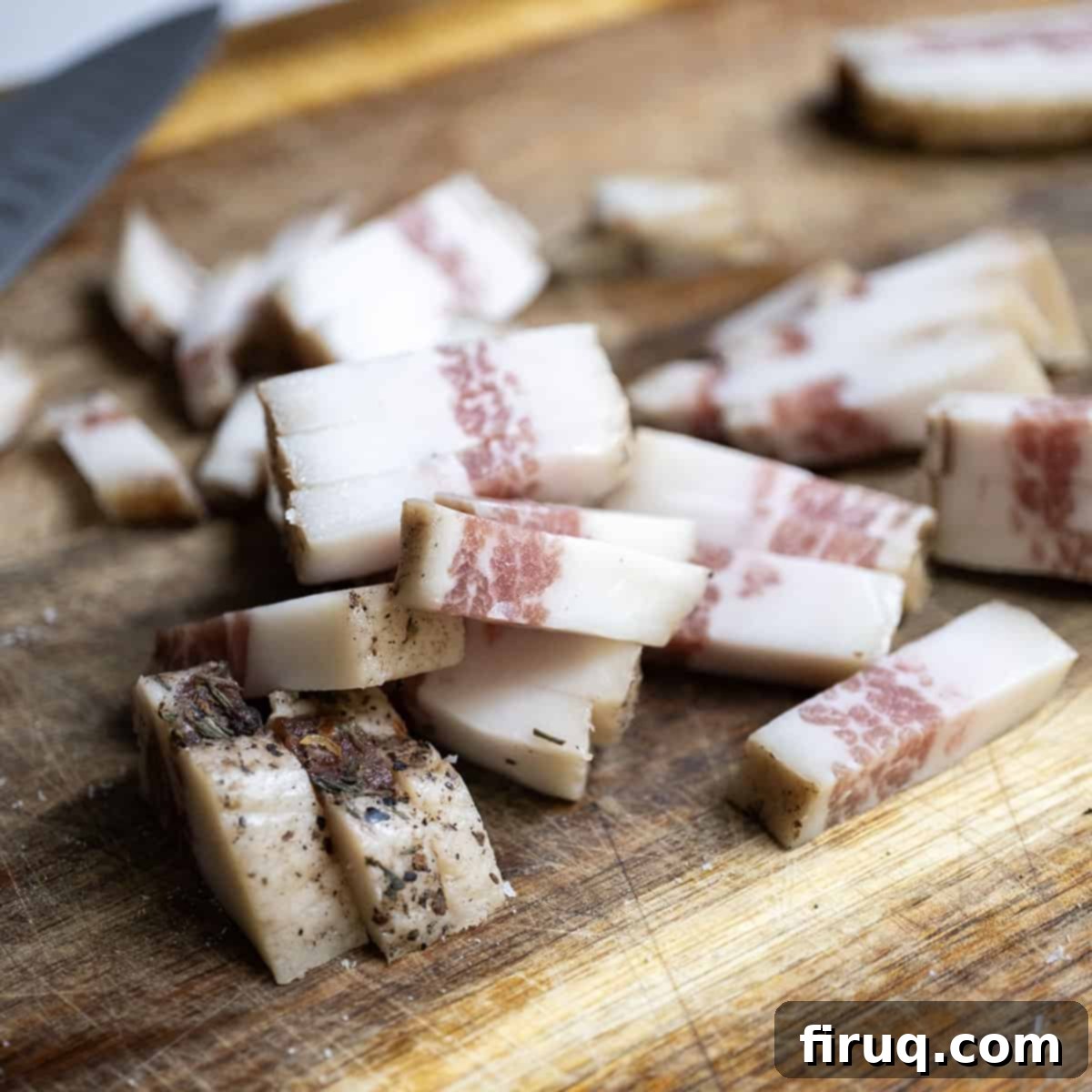
Pecorino Romano. This hard, salty, and tangy cheese, made from sheep’s milk, is the only acceptable cheese for Gricia. Its sharp flavor profile is distinctly Roman and provides the necessary piquancy to balance the richness of the guanciale. The most crucial aspect here is using freshly grated Pecorino Romano. Pre-grated cheese often contains anti-caking agents that prevent it from melting smoothly, leading to a clumpy sauce. For the best emulsification and a velvety finish, grate the Pecorino finely, ideally with a microplane. Do not substitute with Parmesan, as its milder, nuttier flavor will fundamentally change the dish’s character.
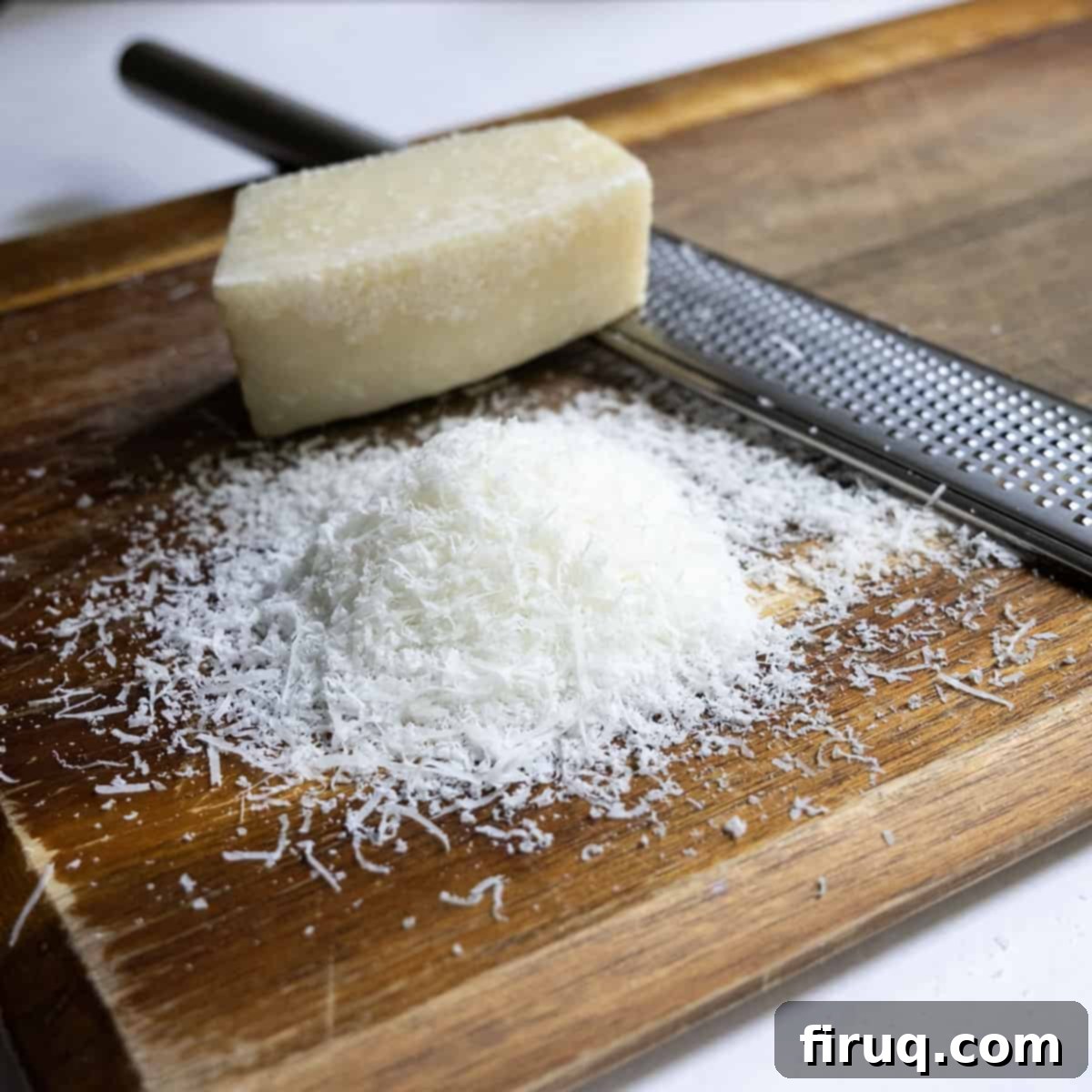
Rigatoni. While Gricia is versatile, a short, tubular pasta like rigatoni is highly recommended. Look for artisanal varieties that appear slightly dusty, indicating a rough, porous surface from bronze dies. This texture is paramount because it allows the pasta to cling to the sauce better and releases more starch into the cooking water, which is vital for creating a creamy, emulsified sauce. Opt for a rigatoni that requires a longer cooking time (around 12-15 minutes) as this usually signifies a higher quality pasta with more starch, contributing to a superior sauce.
Black Pepper. Forget the pre-ground dust in your pantry. Freshly cracked black pepper is non-negotiable for Pasta Alla Gricia. The vibrant aroma and pungent flavor of freshly ground peppercorns add a critical layer of depth and a delightful “kick” that powdered pepper simply cannot replicate. Invest in a good pepper mill and crack your pepper just before adding it to the dish.
*Please refer to the detailed recipe card below for precise measurements and additional ingredient information.
Crafting the Perfect Pasta Alla Gricia: Step-by-Step Guide
Making Pasta Alla Gricia is an exercise in technique and timing. Follow these steps carefully to achieve a truly authentic and delicious result.
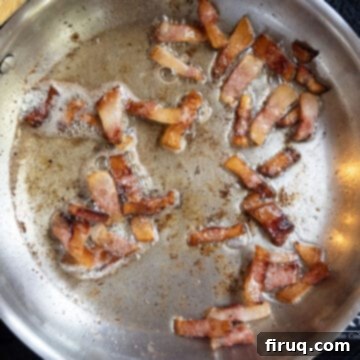
Step 1: Render the Guanciale. Begin by placing the chopped guanciale in a cold pan. This is crucial for gradually rendering the fat. Turn the heat to medium. Slowly fry the guanciale, stirring occasionally, until the fat melts and the meat crisps up to a beautiful golden brown. This process should take approximately 8 minutes, ensuring maximum flavor extraction. Once crispy, remove the guanciale from the pan and set it aside, leaving the rendered fat in the pan. Reduce the heat to medium-low.
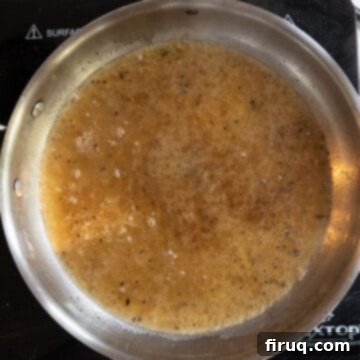
Step 2: Cook the Pasta & Prepare the Sauce Base. While the guanciale is rendering, bring a large pot of generously salted water to a rolling boil. Add your rigatoni and boil it for approximately 1-2 minutes *less* than half the directed time on the package. The pasta will finish cooking in the sauce, absorbing its flavors. Before draining, reserve at least one cup of this starchy pasta water. Add ½ a cup of this reserved pasta water to the pan with the rendered guanciale fat, along with your freshly cracked black pepper. The starch in the water will begin to combine with the fat, forming the base of your creamy sauce.
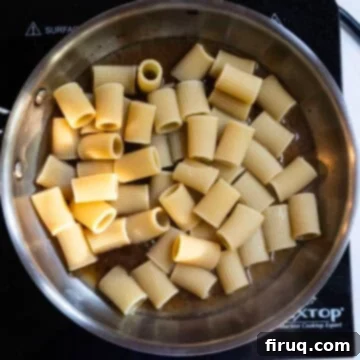
Step 3: Combine Pasta and Sauce Base. Carefully strain your partially cooked rigatoni, ensuring it’s still quite al dente, and immediately add it to the pan with the guanciale fat and pasta water mixture. This transfer should happen quickly to maintain heat and facilitate the emulsification process.
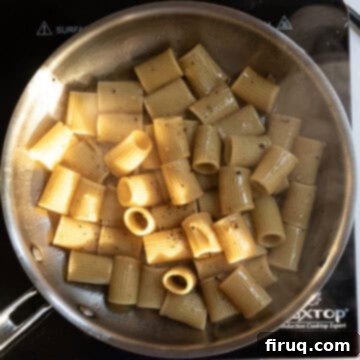
Step 4: Emulsify the Sauce. Allow the pasta to simmer gently in the sauce for about 5 minutes, ensuring to toss or stir continuously and vigorously. This continuous agitation is vital for emulsifying the fat and pasta water, creating a cohesive, creamy sauce. As the pasta finishes cooking, it will release more starch, binding with the guanciale fat and pepper to form that signature Roman creaminess. Add a splash more pasta water if the sauce becomes too dry.
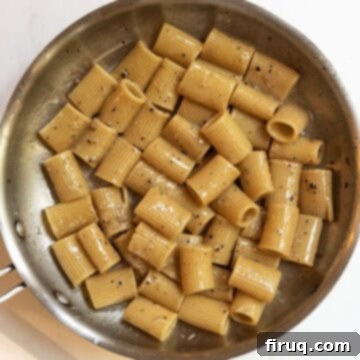
Step 5: Achieve Creamy Consistency. Continue tossing until the sauce visibly starts creaming and develops a rich, glossy, and silky appearance. It should coat the pasta beautifully, signaling a perfectly emulsified sauce.
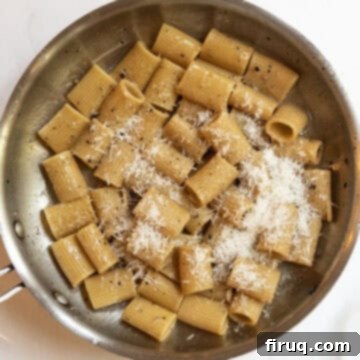
Step 6: Incorporate Pecorino Romano. Remove the pan from the heat entirely and let it cool for 1-2 minutes. This brief cooling period is essential to prevent the cheese from clumping. Now, add in half of the freshly grated Pecorino Romano and continuously stir or toss the pasta. As the cheese melts, it will thicken the sauce. Gradually add another tablespoon or two of reserved pasta water, continuing to toss vigorously as you slowly incorporate the remaining Pecorino. The goal is a velvety, slightly runny sauce that coats each piece of pasta, similar to the consistency of a runny egg yolk.
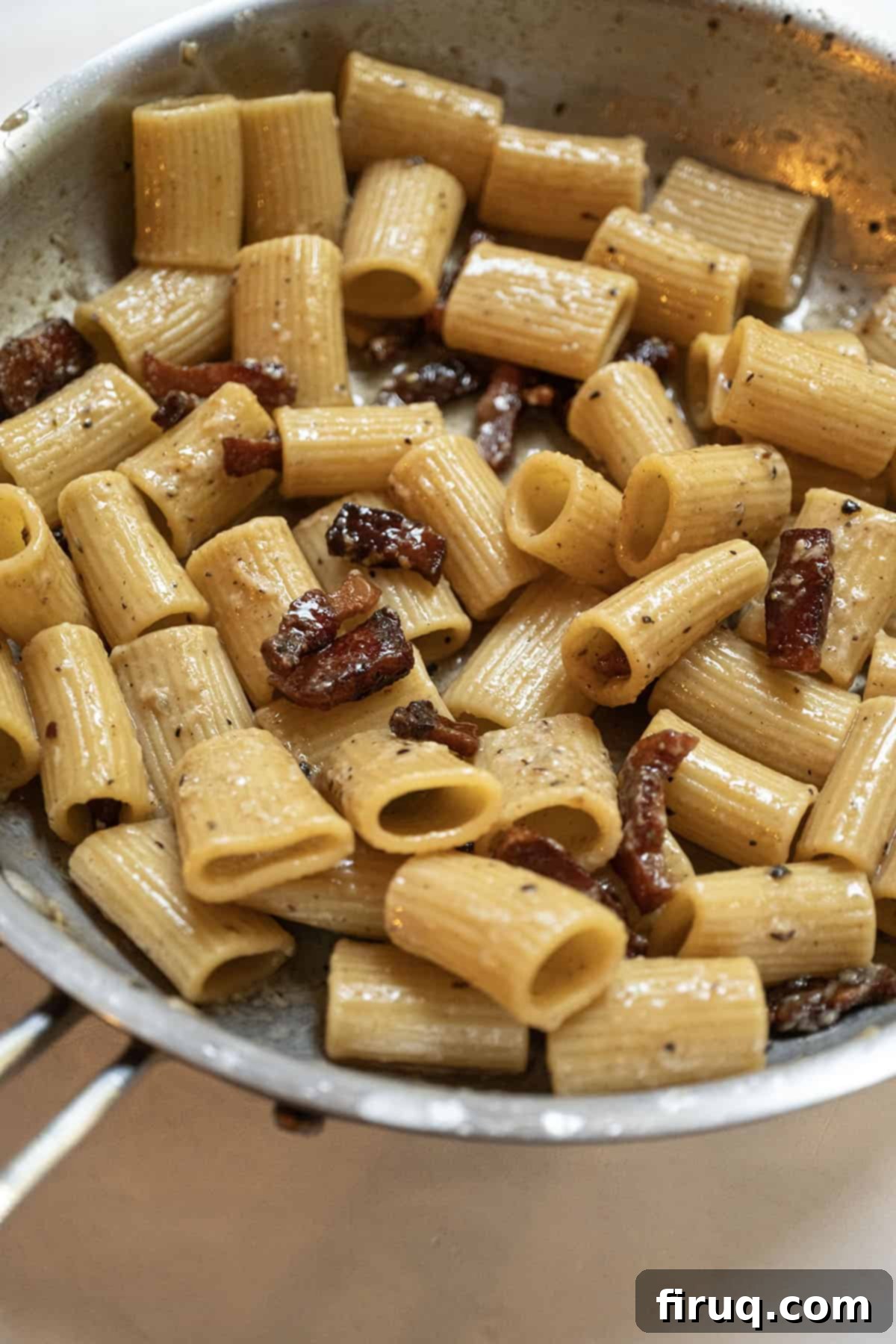
Step 7: Final Mix and Serve. Return the crispy guanciale to the pan with the pasta and sauce, tossing to combine thoroughly. Serve the Pasta Alla Gricia on a warm plate immediately. This dish is best enjoyed fresh to appreciate its creamy texture and distinct flavors.
Traditionally, Pasta Alla Gricia is served as a *Primi* (first course) in an Italian meal, preceding the main meat dish. We often serve it before a delicious protein like our Restaurant-Style Chicken Francese or a classic Restaurant-Style Chicken Marsala. Complement your meal with a fresh vegetable side such as Sautéed Rapini with Garlic or savory Garlic Parmesan Green Beans.
Pro-Tips for Perfect Pasta Alla Gricia
Achieving Gricia perfection requires attention to a few key details:
- Cold Pan for Guanciale: Always begin frying your guanciale in a cold pan. This allows the fat to render slowly and evenly, resulting in perfectly crispy meat and a maximum release of flavorful oil, which is the soul of your sauce.
- Master the Emulsification: The most crucial step is emulsifying the sauce. Once you add the pasta to the rendered guanciale fat and pasta water, continue tossing vigorously or stirring for at least 5 minutes. This creates a stable emulsion where the fat, water, and starch from the pasta bind together, leading to that signature creamy, velvety Roman sauce, much like the technique used for a Traditional Caesar Dressing.
- Finely Grate Fresh Pecorino: Use only finely grated fresh Pecorino Romano cheese. The fine texture ensures the cheese melts seamlessly into the sauce without clumping, creating a smooth and luscious finish. Remember to always remove the pan from the heat for a minute or two before incorporating the Pecorino to prevent it from seizing or becoming stringy.
- Don’t Overcook the Pasta: Cook your pasta well under al dente in the boiling water, as it will continue to cook and absorb flavor in the sauce. This final cooking in the pan is crucial for the pasta to release its starches and become one with the sauce.
Pasta Alla Gricia: Your Questions Answered
Pasta alla Gricia is a classic Roman dish, often called “white Amatriciana” or the “ancestor” of other Roman pastas. It features a rich, creamy sauce made from the rendered fat of guanciale, emulsified with starchy pasta water, and finished with a generous amount of finely grated Pecorino Romano cheese and freshly cracked black pepper. It’s renowned for its incredible depth of flavor from minimal, high-quality ingredients.
While technically possible, Pasta alla Gricia does not reheat well. As an emulsified sauce, it’s best enjoyed immediately after preparation. Storing it cold and then reheating typically causes the fat and water to separate, leading to a greasy and clumpy texture rather than the desired silky creaminess. For the best experience, prepare and serve it fresh.
The primary difference between Pasta alla Gricia and Carbonara lies in the egg. Carbonara incorporates egg yolks (and sometimes whole eggs) to create its distinctively rich and creamy sauce, along with guanciale, Pecorino Romano, and black pepper. Gricia, on the other hand, achieves its creamy texture solely through the careful emulsification of guanciale fat and starchy pasta water, without any egg.
Cacio e Pepe is a minimalist Roman pasta, meaning “cheese and pepper,” and traditionally contains no meat. Its sauce is created by emulsifying only Pecorino Romano cheese, black pepper, and pasta water. Pasta alla Gricia, conversely, is characterized by the inclusion of guanciale (cured pork jowl), which provides a rich, savory fat base that significantly contributes to the sauce’s flavor and texture alongside the Pecorino and pasta water.
Explore More Authentic Pasta Recipes
If you loved crafting this classic Roman pasta, you’ll surely enjoy exploring other delicious Italian dishes. Here are a few more pasta recipes from our kitchen that you might like:
- Creamy Pesto Shrimp Pasta
- Creamy Red Pepper Sauce
- Linguine with Red Clam Sauce
- Quick Lamb Ragu with Pappardelle
Please leave a comment and star rating below in the recipe card! We love to hear what you think of our recipes and your culinary adventures. Feel free to tag us on Instagram @vindelgiudice when you share your delicious creations.
📖 Recipe
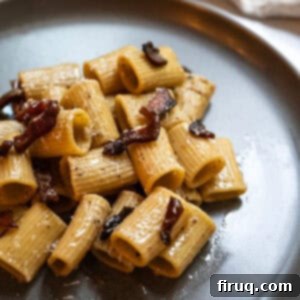
Pasta alla Gricia
Vincent DelGiudice
Pin Recipe
Equipment
-
1 large saucepan
-
1 large pot
Ingredients
- ½ lb Rigatoni
- 1 cup pecorino romano, finely grated
- 2 teaspoon black pepper (freshly cracked)
- 4 oz guanciale, cut into small strips or cubes
Instructions
-
Chop the guanciale into small strips or cubes and place it in a cold saucepan. Raise the heat to medium. Slowly fry the guanciale, stirring occasionally, until the fat fully renders and the meat becomes beautifully crispy and golden brown, which should take about 8 minutes. Remove the crispy guanciale pieces and set them aside, leaving the rendered fat in the pan. Lower the heat to medium-low.
-
While the guanciale is rendering, bring a large pot of generously salted water to a boil. Add your rigatoni and cook it for 1-2 minutes *less* than half the directed cooking time on the package (it should be very al dente). Before draining, reserve at least one cup of the starchy pasta water.
-
Add the freshly cracked black pepper to the rendered guanciale oil in the pan and stir for about 30 seconds to toast the pepper. Then, add ½ cup of the reserved pasta water to the pan. Immediately strain the partially cooked rigatoni and add it directly to the saucepan with the sauce base.
-
Let the pasta simmer in the sauce for about 5 minutes over medium-low heat, tossing continuously and vigorously. This continuous agitation is key to emulsifying the guanciale fat and starchy pasta water, creating a rich and creamy sauce. Add splashes of additional pasta water, if needed, to achieve a fluid consistency.
-
Remove the pan from the heat and let it cool for 1-2 minutes. This brief cooling prevents the cheese from clumping. Add in half of the finely grated Pecorino Romano and continuously stir or toss the pasta. Add another tablespoon or two of pasta water and continue tossing as you slowly add the remaining Pecorino. Keep tossing until the sauce is velvety, glossy, and has a slight runny consistency, similar to a runny egg yolk. Return the crispy guanciale to the pan, toss to combine, and serve immediately on warm plates.
Notes
- Always start frying guanciale in a cold pan. This method ensures the fat renders slowly and perfectly, leading to crispy meat and a maximum release of flavorful fat, essential for the sauce.
- Emulsification is crucial. After adding pasta to the pan, toss continuously for about 5 minutes. This process binds the fat, starch, and water, creating the signature creamy, smooth sauce. Adjust with more pasta water as needed.
- Use finely grated fresh Pecorino Romano. Pre-grated cheese can clump. Ensure the pan is off the heat for a minute or two before adding the cheese to prevent it from seizing and to create a velvety sauce.
- Do not overcook the pasta in the boiling water. It will finish cooking in the pan, absorbing the sauce’s flavors and releasing essential starches for the emulsion.
